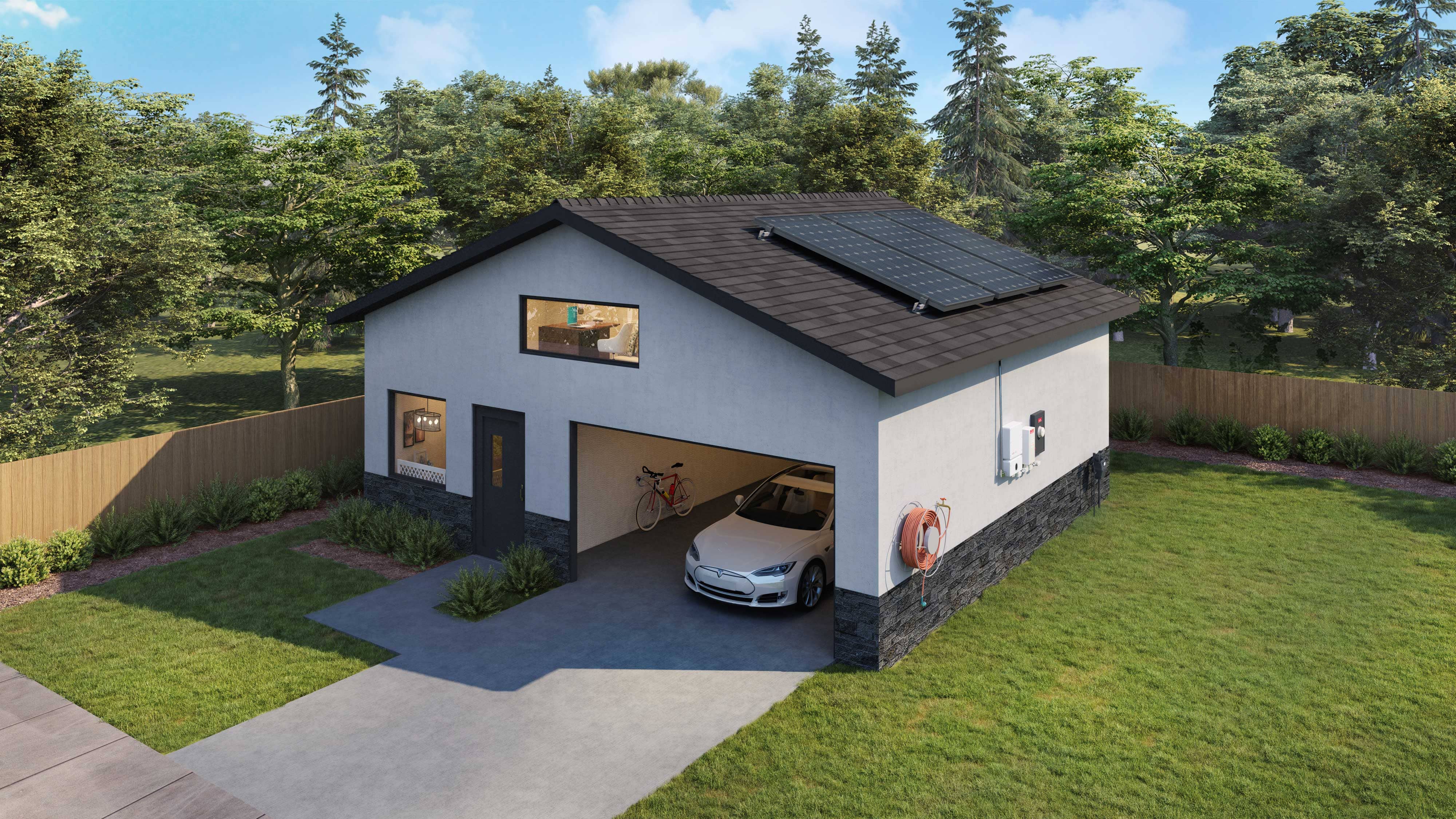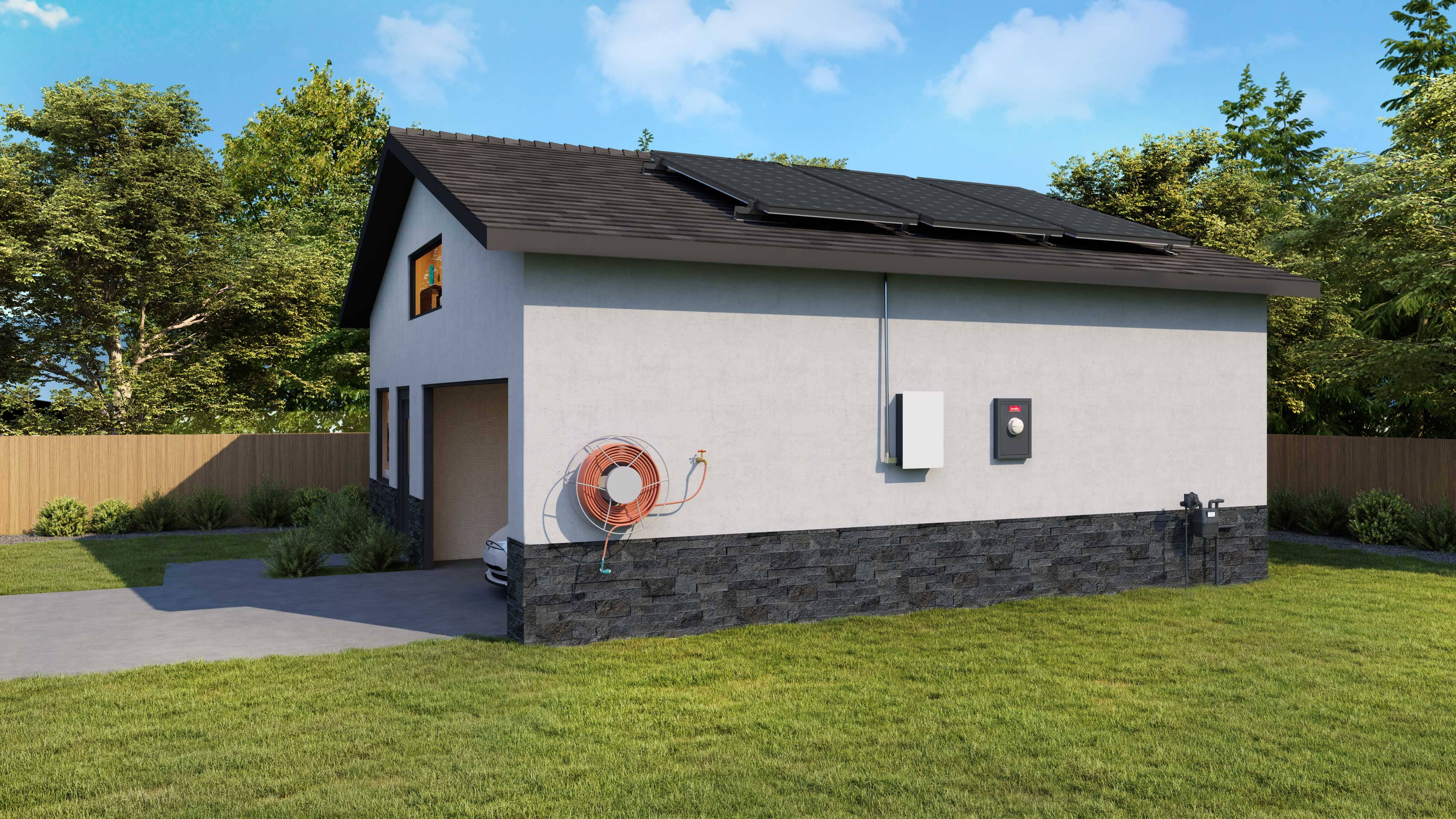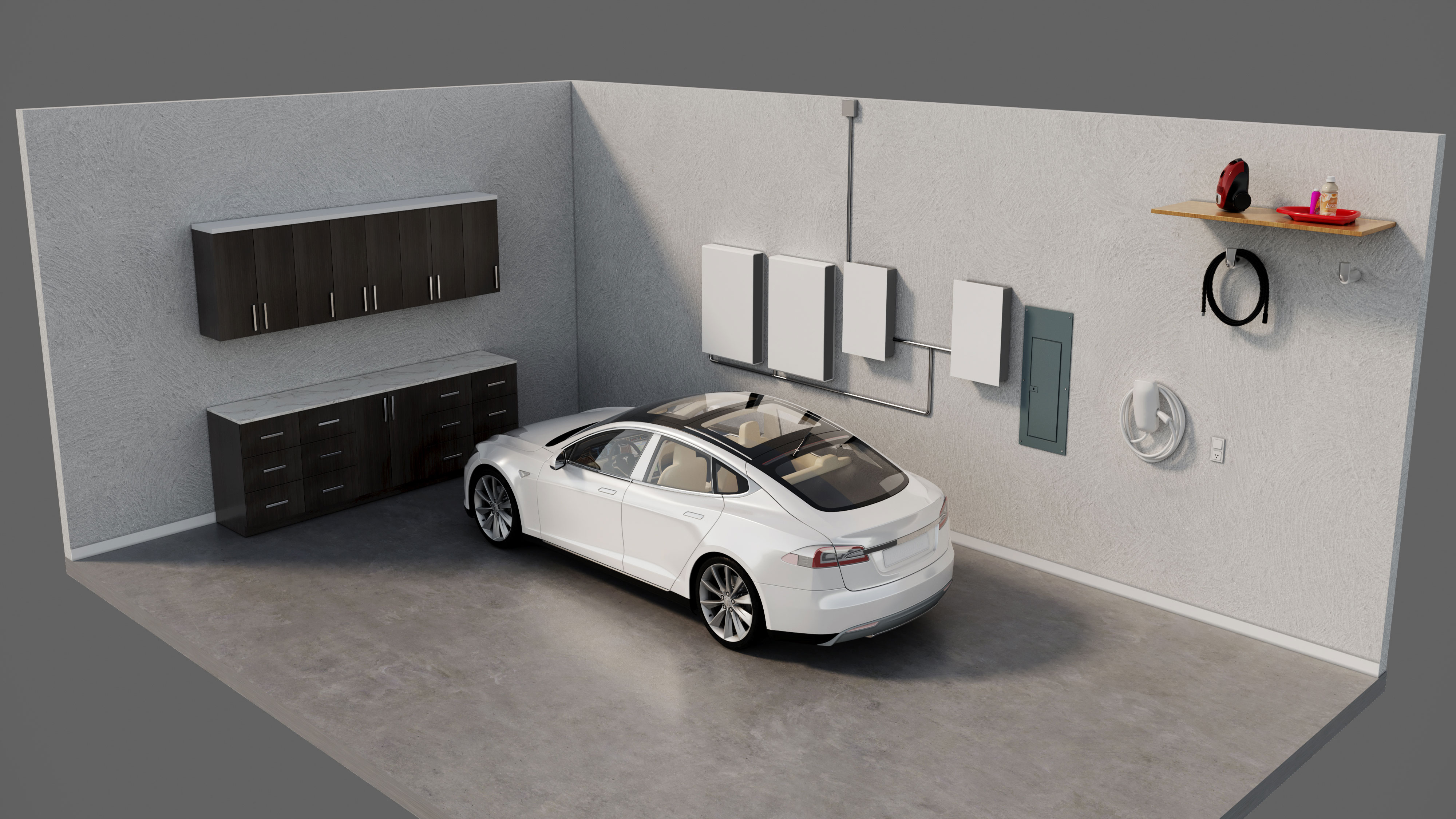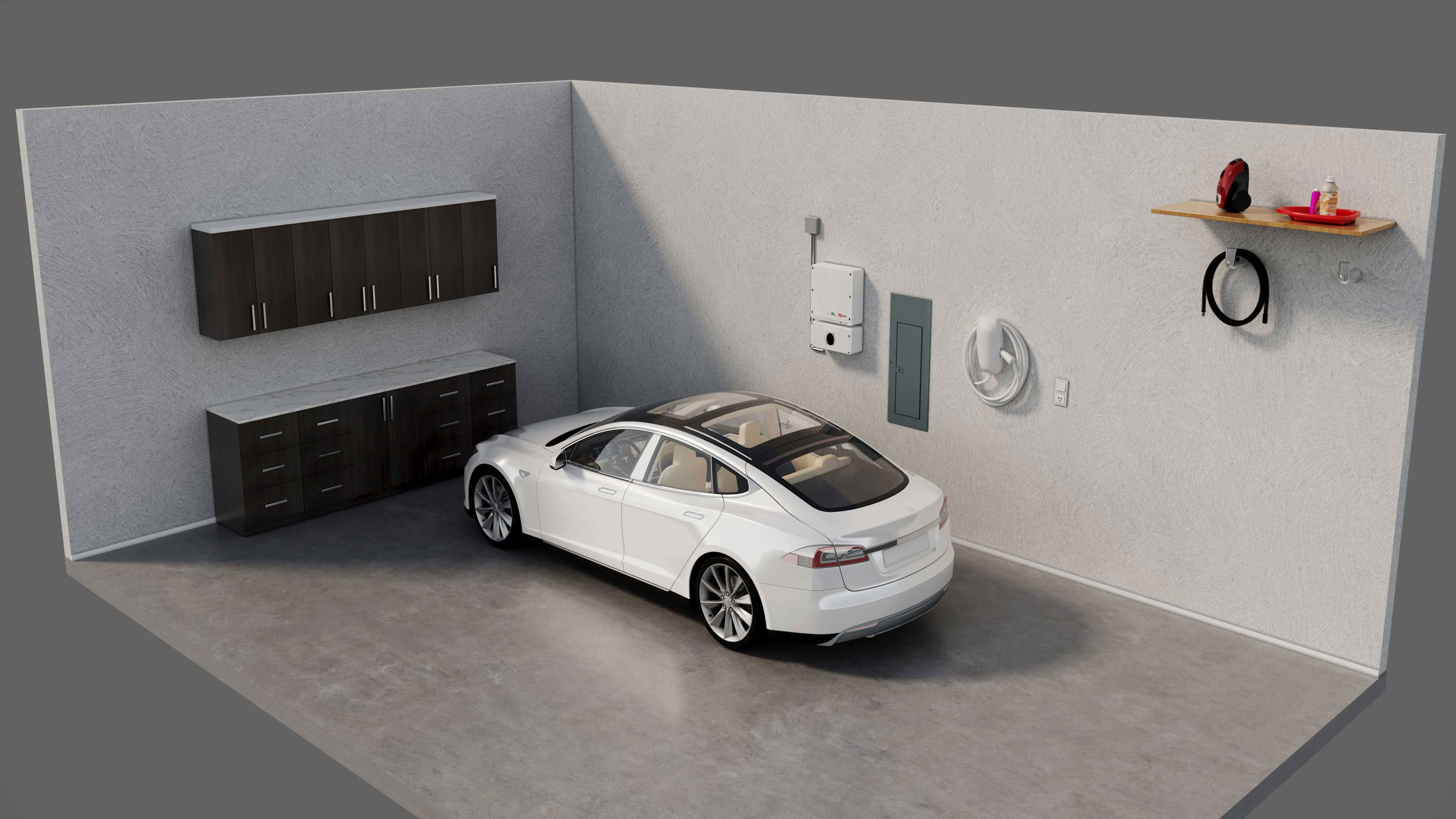Learning ahead! Use these quick links to answer your questions.
Interactive Home Energy Management System
We are excited to announce the release of our new interactive home! We aim to educate and set expectations for how solar, battery, and EV charging equipment goes in your home. The configurations in our interactive feature follow what we typically see for homes going solar only or solar + battery. Final product placement and orientations may vary depending on your existing electrical infrastructure, space, and purchased products. Check it out and learn about all the pieces that will help you achieve energy independence through a home energy management system!

Roof Type
We can install solar on composite shingles and flat and metal roofs. If you need to replace your roof, why not do it with a solar roof!
Solar Panels
We use black framed panels with black back sheets to provide a sleek and uniform array that looks great and generates heaps of energy year-round! Check out our current offer on our Products page.
Computers/Electronics
Manage your home energy systems via mobile apps or on your computer through browser-based monitoring apps!
Lights
Power your lights and home loads sustainably and for free with solar during the day and by batteries at night

Racking
Racking is the equipment used to install solar panels on your roof. Depending on the roof type, there may be different attachment methods to secure the panels to the roof. The typical clearance between the panel and roof is 4-5 inches.
Rooftop Penetration
Connecting the solar array with the equipment on the side of the house may require penetration. The penetration is usually through the overhang or eave of the roof; if no eave is present, the conduit is bent to subtly connect the solar panels with the equipment on the side of the house.
Water Source
The code requires a three-foot setback from all water sources when installing equipment on the side of the home.
Backup Gateway
It is the brains of your battery energy storage system. You can connect solar and other home loads into the internal breaker board in the BUG. It can also serve as the service disconnect to adhere to code.
Meter
It is what the utility uses to track how much electricity you use. When you install solar, the utility will swap your meter with a bi-directional meter that reads the energy you send out to the grid, which is critical for receiving credits for the excess energy you produce.
Electrical Conduit
The conduit is surface mounted on the roof and side of the house. To run a hidden conduit through the attic and frame of the house will require more planning and costs, but it is an option that we are happy to explore with you.
Gas Main
Require a three-foot setback for all solar and electrical equipment to adhere to code.

Racking
Racking is the equipment used to install solar panels on your roof. Depending on the roof type, there may be different attachment methods to secure the panels to the roof. The typical clearance between the panel and roof is 4-5 inches.
Rooftop Penetration
Connecting the solar array with the equipment on the side of the house may require penetration. The penetration is usually through the overhang or eave of the roof; if no eave is present, the conduit is bent to subtly connect the solar panels with the equipment on the side of the house.
Water Source
The code requires a three-foot setback from all water sources when installing equipment on the side of the home.
Inverter
Both micro and string inverters will have equipment on the side of the house which connects all the arrays installed on the property. This equipment can serve as a disconnect and will connect to your electrical panel if adequate electrical capacity allows. Inverters are necessary to turn the DC energy from the solar panels into AC energy that your home can use!
System Disconnect
It is a piece of equipment meant to shut down the system as a safety measure rapidly. A disconnect safely connects to your electrical equipment via a line side tap when electrical panels don’t have enough electrical space for a back feed breaker.
Meter
It is what the utility uses to track how much electricity you use. When you install solar, the utility will swap your meter with a bi-directional meter that reads the energy you send out to the grid, which is critical for receiving credits for the excess energy you produce.
Electrical Conduit
The conduit is surface mounted on the roof and side of the house. To run a hidden conduit through the attic and frame of the house will require more planning and costs, but it is an option that we are happy to explore with you.
Gas Main
Require a three-foot setback for all solar and electrical equipment to adhere to code.

Electrical Conduit
It is surface mounted in the garage unless a hidden conduit run is requested. Hidden conduit means penetrating through the walls and removing sheetrock to accommodate a safe installation.
Battery Backup
Do you mean to use your solar panels during a grid outage? Off-grid solar usage is only allowed if you have a battery backup to send excess energy. Depending on the manufacturer, Batteries can be wall mounted or mounted on the ground.
Inverter
If the inverter is inside the garage, there is still the requirement of a service disconnect on the outside. Both micro and string inverters will have equipment at the ground level which connects all the arrays installed on the property. The utility or emergency responders must be able to shut the energy systems down quickly. Inverters are necessary to turn the DC energy from the solar panels into AC energy that your home can use!
Backup Gateway
It is the brains of your battery energy storage system. You can connect solar and other home loads into the internal breaker board in the BUG. It can also serve as the service disconnect to adhere to code, but if it’s installed inside the garage, we must install a disconnect outside.
Electrical Panel
It is the electrical equipment in each building that energizes all of the loads. Both solar and battery equipment interconnect with your electrical panel via a back feed breaker of a line side tap. SPAN smart panels allow you to maximize you control over your energy usage and can increase your battery capacity by 40% through load management software at the tip of your fingers!
EV Charger
Connect to your electrical panel and charge your EV. You can install a NEMA 14-50 outlet for an adaptable charging method or hardwire your EV charger for the most reliable, weather-tight, and fastest charging experience.

Electrical Conduit
It is surface mounted in the garage unless a hidden conduit run is requested. Hidden conduit means penetrating through the walls and removing sheetrock to accommodate a safe installation.
Inverter
If the inverter is inside the garage, there is still the requirement of a service disconnect on the outside. Both micro and string inverters will have equipment at the ground level which connects all the arrays installed on the property. The utility or emergency responders must be able to shut the energy systems down quickly. Inverters are necessary to turn the DC energy from the solar panels into AC energy that your home can use!
Electrical Panel
It is the electrical equipment in each building that energizes all of the loads. Both solar and battery equipment interconnect with your electrical panel via a back feed breaker of a line side tap. SPAN smart panels allow you to maximize you control over your energy usage and can increase your battery capacity by 40% through load management software at the tip of your fingers!
EV Charger
Connect to your electrical panel and charge your EV. You can install a NEMA 14-50 outlet for an adaptable charging method or hardwire your EV charger for the most reliable, weather-tight, and fastest charging experience.
Solar FAQs
-
Does solar really work in Washington – isn’t it too cloudy here?

Solar works in all parts of Washington. Anytime there is daylight, the photovoltaic (PV) panels will produce electricity, with more power produced on sunny days than on cloudy ones. Because we experience very long hours of daylight and sunny weather in summer, power output in July is about six times greater than in December. And Net Metering (one-for-one credit of KWH) allows excess electricity from summer sunshine to be “banked” to reduce subsequent electric bills. Rain and snow help keep the modules clean for less maintenance and higher production. Solar systems operate more efficiently in our cooler temperatures than in warmer places like Arizona.
-
What is the right size solar system for me?

We look at several key factors when designing a residential or commercial solar system for you in Washington State. First is usable roof space. We consider setbacks required by law, avoid shaded areas, and avoid chimneys and skylights. Second, we design the system so that the array’s yearly electrical output does not significantly exceed your annual electricity usage, determined by your electricity bill. The third is your budget.
We design options to be both affordable and cost-effective over the long haul. We partner with credit unions that offer zero-down low-interest solar loans. Each module is approximately 66” by 40” and takes up about 20 square feet, so about 800 square feet of roof space is needed for a 40-module array.
We measure system size in KW (kilowatts). Each solar panel has a wattage rating. Multiply the panel’s watts by the total number of panels to get the system size [for example: If each solar panel is 300 watts, then a 40-module array is a 12 KW or 12,000-watt solar system]. Whether your project is residential or a large commercial operation, our electricians in Washington State will tailor the size to meet your goals.
-
What factors affect the power output of a solar system?

The following factors determine the power output of each solar panel in the system.
Azimuth – describes whether the roof faces south, east, or west. South or southwest is best. We measure azimuth in degrees with 180 degrees as due south, and east is 90 degrees, west is 270 degrees.
Tilt – denotes the pitch or angle of the roof.
Location – the longitude and latitude determine average weather, affecting typical solar resources over an average year.
Shading – we measure how much the solar resource is affected by trees, buildings, wires, etc., that shade the roof.
Wattage – each solar panel is flash tested at the factory to determine the nameplate rating in watts. In general, most of the panels we install today are in the range of 390 to 420 watts each for 60 cell panels.
With these inputs, sophisticated software extrapolates the annual output in kWh for an average year for your specific site.
-
What happens when there is a power outage?

During a power outage, the solar energy system automatically shuts down unless you have battery backup—a required safety feature to protect utility workers working on the power lines.
A solar energy system is not a source of backup power. A grid-tied solar energy system requires the presence of the grid or battery energy storage system to function during a power outage.
-
I’m not sure how long I will live here. What happens if I want to sell my house a few years after I go solar?

Your house will appeal more to buyers because solar will always have a lower electric bill than a comparable house without solar. The new owner will benefit from Net Metering. You will already have received the federal income tax credit and earned back that portion of your upfront cost. Last, if you received a loan to pay for solar, you need to pay off the loan. A solar array adds more value to your home than it costs. The best thing to do is to leave the solar on the house rather than try to take it with you.
-
Do you offer a referral program if I send friends to you?

We offer a referral program for residential solar systems in Washington State. It is $100 per kW, up to $1,000. So, if you refer a friend and they buy a 7kW system from us, we will give you $700.
-
Can you help with financing?

Yes. We recommend working directly with a statewide credit union. Contact the experts at PSCCU (Puget Sound Cooperative Credit Union) for any residential or commercial project. You can fill out the loan application online. Our Washington State team of electricians will provide you with all the technical details about the system. Upon your approval, they can send your down payment directly to us. Secure online signatures are part of our online processing.
-
What maintenance is required for solar?

One of the best things about a solar array is its low maintenance. Please, check out our blog on maintaining your solar panel equipment for more details. When you go solar with us, we will provide instructions in your Owners Manual (soft brush and water work best). We strongly recommend annual cleaning near the end of pollen season, usually in May, when you notice green sticky pollen on the surface, depending on how well the rain has cleaned your panels. You want your system to perform best during the sunny summer months. Use your online monitoring system to see the power output of each meeting to make sure there are no problems. NWES offers an annual maintenance package for $1000/year in which we will come out to your place twice a year to clean the solar panels and inspect the system, or we can clean your modules “a la carte.” Just contact us to schedule this service with our maintenance team.
Battery Backup FAQs
-
What happens when there is a power outage? Do I have to turn my battery backup on manually?

Whenever a power outage occurs, both Tesla and Enphase battery storage systems automatically turn on backup energy. Like the Automatic Transfer Switch used with gas generators, battery energy storage systems allow you to seamlessly transition to backup power, followed by a notice on your companion app for your respective battery manufacturer.
-
Do you offer a referral program if I send friends to you for a battery storage system?

Yes! We offer $100 per battery unit if your referral installs a battery storage system. If they install two Powerwalls, you will get $200.
-
If I purchase a battery energy storage system without solar can I still qualify for the 30% investment tax credit?

Yes! Stand-alone battery energy storage systems qualify for the 30% Federal Investment Tax Credit.
-
What type of battery backup do you offer?

Both our residential and off-grid battery offers utilize Lithium battery technology. Maximizing the depth of discharge that can occur without damage to the batteries. Check our battery offers in more detail on our Battery Backup page.
-
How many home loads can I cover with partial backup?

Partial backup can cover up to 120A worth of breakers. Depending on the battery storage manufacturer, the 120A breakers can be no larger than 30A for Powerwall and no larger than 20A for Enphase IQ batteries. Large loads such as AC units and laundry typically use 50A breakers, and if you want to use these appliances during a power outage, it is recommended to add at least two to three batteries. We can help you find the correct configuration of battery backup to meet your needs!
-
Is there a certain amount of solar that can charge a battery?

Depending on the battery backup manufacturer, different solar-to-battery (PV:ESS) ratios will ensure safe charging. Tesla Powerwall batteries have a 7.6kW AC PV:ESS ratio, while FranklinWH has a 5kW AC PV:ESS ratio.
EV Charging FAQs
-
Can I charge my plug-in electric vehicle from solar?

Solar energy produced from your solar panels provides energy for all loads in your home. Charging your EV at home is like powering a load such as a TV or electric stove top. The electricity flowing through your home may be from the grid or your solar panels; if it’s during a sunny, cool day and your panels produce power, there’s a good chance your EV is being charged by the energy you create. If it’s in the afternoon or night, that energy charging your car comes from the grid. Excess power generated during the day is credited to the utility, which then is used at night, so you are still offsetting the usage you’d otherwise be paying for by having solar panels.
-
Can I charge my EV from my home battery backup when the grid goes down?

Although highly not recommended, you can charge a plug-in electric vehicle from a Powerwall storage battery. We must warn you that charging an EV battery from a house battery will quickly drain the battery and be very inefficient. The discharge rate for charging your EV can lead to long-term issues such as reduced storage capacity.
-
Can I charge my plug-in electric vehicle from solar when the grid goes down? Can my house use my EV battery when the grid goes down?

Today, you cannot charge an EV at home directly from solar when there is a power outage. This is due to solar shutting down if there is no battery backup source to send energy to.
With EVs such as the Ford F-150 lightning, you can use your EVs battery to power your home during grid outages. Check out our blog on this awesome technology to learn more!
-
At what rate does a level 1 charger charge my EV?

With level 1 charging, you can see a charge rate of up to 8 miles per hour of charge. This is best for short commute times, a consistent charging routine, and charging sources outside your home, like at the office. Here is our blog that covers EV charging from home.
-
At what rate does a level 2 charger charge my EV?

The charge rate for level 2 chargers is up to 25 miles per hour. To have this at your home requires an assessment by a qualified electrical company like NWES to see if your home’s electrical panel has space for the level 2 charger outlet. Here is our blog that covers EV charging from home.

